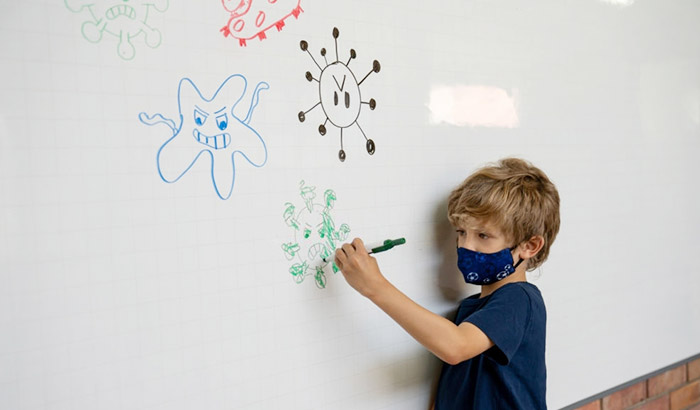10 Fun Things You Can Draw On A Whiteboard That Teach Kids Important Tips

As an educator, you know that learning is a process. And it’s one that doesn’t end when the school bell rings or the last test is taken. Learning is something that continues in our lives from day-to-day, moment-to-moment and experience-to-experience. As such, you constantly look for ways to incorporate education into your teaching strategy so that your students learn as much as possible with every lesson. You see value in incorporating fun activities into your classroom because they make learning more accessible and memorable for your students. In order to help you get started with introducing new activities into your classroom, we compiled a list of 10 fun things you can draw on a whiteboard that teach kids important tips!
Add Some Color
During your next classroom discussion, add some color to the conversation by writing each word on the board in a different color. In this way, your students will associate the word with the color as well as the concept. This can help your students to remember the concepts in your lesson for a much longer period of time by using both their visual and auditory senses. You can try this out with any lesson from any subject. This is a great concept for elementary school students who just started their journey into the world of academics. Color is an essential part of our visual language and can help students remember certain things better. When you are writing something on a whiteboard, you should always choose a color that is relevant to the topic. If you can, use a few different colors to make the information even more memorable.
Draw A Map
Sometimes, you may be teaching a lesson that involves a map. In these cases, you can draw a map on the whiteboard and ask your students to label the different parts of it. This can be a great way to get your students to start thinking around the topic that you’re discussing. It can also help them to find a starting point from which to build their understanding of the topic. You can also draw a map without having a specific lesson in mind. This can be a great way for your students to engage with each other and share whatever information they have about various topics. This works really well for younger students or for those at the start of their education journey as a way to spark their curiosity about the world. If you’re teaching a specific subject, you can also use maps to get students to start thinking critically about the topic.
Don’t Forget To Breathe
During your next lesson, draw a giant reminder to your students to breathe on the whiteboard. Breathing is an essential part of the human experience, but it’s something we sometimes forget to do. With the hectic pace of modern life, it’s even more important that we take some time out to take a few deep breaths. Breathing exercises have been shown to have a wide range of health benefits. They can help to increase productivity, reduce stress and improve positive mentality. When you draw a reminder to your students to breathe, you’re giving them an opportunity to step away from the lesson and just breathe for a few moments. This can be really beneficial for students who are particularly excited about the topic you’re discussing. It can also be a great way for students with anxiety to take a step back from the stress of the lesson and take some time to calm down.
It’s Okay To Make Mistakes
During your next lesson, draw a giant reminder to your students that it’s okay to make mistakes. Mistakes are a natural part of the learning process. In fact, according to research, the most effective learning takes place after a mistake has been made. When you’re teaching, you want to create an environment where students feel comfortable making mistakes. This is important because it helps students to feel less anxious about the learning process. Anxiety can have a major impact on students’ ability to learn. It can make it harder for them to concentrate and find it difficult to process information. An important thing to remember here is not to punish students for making mistakes. Making mistakes is part of the learning process. It doesn’t mean that students aren’t smart enough or aren’t paying attention. It just means that they’re trying to figure out the topic as they go along.
Try Out New Things
During your next class, encourage your students to try out new things by drawing a reminder to them on the whiteboard. As educators, you’re constantly asking your students to try out new things and to not be afraid to explore. But it’s important for the lesson to go both ways. If your students are always exploring new things, you miss out on the opportunity to learn from them. So, make sure that you encourage your students to try out new things and push their boundaries while you still have the chance. This can be a great way to get students thinking critically about the topic you’re discussing. This also gives you an opportunity to find out more about your students. You can ask them to keep a journal of their explorations or create a blog where they can document their findings. This can be especially beneficial for younger students who are still trying to find their voices.
You Can Always Bounce Back
During your next lesson, draw a giant reminder to your students that they can always bounce back from their mistakes. Mistakes are a natural part of the learning process, but that doesn’t mean that they’re easy to deal with. Many students feel embarrassed or ashamed when they make mistakes. This can make them reluctant to explore new topics or even ask questions. You can help students to feel less ashamed of their mistakes by reminding them that they can always bounce back. This can be especially useful with younger students who are just starting out in their education journey. They may not have yet developed the skills to cope with the negative emotions that come with making mistakes. Bouncing back from a mistake often involves finding a way to forgive yourself. It can be helpful to sit down with your students after they make a mistake and discuss a few ways that they can forgive themselves.
Take Care Of Yourself
During your next lesson, draw a giant reminder to your students that they need to take care of themselves. This is a very important reminder for your students to keep in mind as they go about their daily lives. This is especially important for students who might be dealing with a lot of stress in their lives. By drawing this concept on the board, you can help your students to remember to take care of themselves. This can be a valuable reminder for students who are particularly engaged in their studies or who have extracurricular activities. It can also be beneficial for students who are experiencing a lot of stress in their daily lives. Sometimes, students are so focused on taking care of others that they forget to take care of themselves. By drawing this concept on the board, you can give your students an important reminder.
Don’t Be Afraid To Ask For Help
During your next lesson, draw a giant reminder to your students that they don’t need to go it alone. Everyone needs help sometimes. Whether it’s with a school project, a sport or another extracurricular activity, everyone can use a little extra help. That doesn’t make someone less capable or intelligent. That just means that everyone needs some assistance from time to time. Drawing this concept on the board can be a helpful way for your students to engage with the lesson. They can ask each other questions related to the topic of the lesson. Or they can ask questions related to whatever they’re working on.
Conclusion
A whiteboard is a great classroom tool since there’s nothing quite like the thrill of seeing something written in big, bold letters appear before your eyes. There are many different things you can draw on a whiteboard to engage your students, inspire creativity or put a fresh spin on an old lesson. Whiteboards are a great way to bring your classroom to life.





